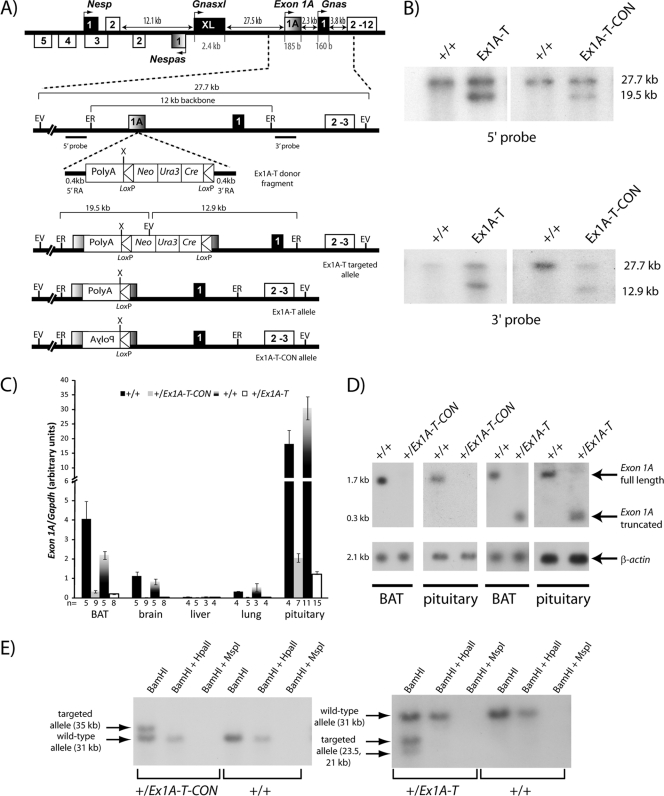Fig 2.
Insertion of a poly(A) cassette into the Exon 1A exon in both orientations. (A) Schematic overview of insertion in the targeted alleles. A 12-kb EcoRI fragment containing the Exon 1A exon and Gnas exon 1 was cloned into yeast shuttle vector pRS414. A donor fragment containing a rabbit β-globin poly(A) cassette (in either the forward or the reverse orientation); the Neo, Ura-3, and Cre genes between two loxP sites; and 0.4-kb recombinant arms on each side homologous with the 5′ and 3′ sequence of the insertion point in the Exon 1A exon, was also transformed into yeast. Both yeast constructs were then linearized and electroporated into ES cells, where they were screened for homologous recombination by Southern blot analysis. ER, EcoRI; EV, EcoRV; X, XhoI. (B) Screening for correct targeting by Southern blot assay. Genomic DNA from ES cells was digested with EcoRV and hybridized with 5′ and 3′ probes, respectively. The wild-type allele gives rise to a 27.7-kb fragment, while the targeted allele will give rise to a 19.5-kb or a 12.9-kb fragment for the 5′ and 3′ probes, respectively. (C) Real-time RT-PCR analysis of the Exon 1A transcript upon paternal transmission in newborn tissues. Primers were designed from the end of the Exon 1A exon to the start of Gnas exon 2. Expression was normalized to Gapdh. Error bars indicate the standard errors of the means. (D) Northern blot assay of Exon 1A and a β-actin loading control in newborn tissues. Pituitaries were pooled in groups of two, with a total of 4 animals being analyzed; BAT is representative of 10 to 14 samples analyzed per genotype. (E) Southern blot analysis of methylation of the Exon 1A promoter. Genomic DNA was first cut with BamHI to generate the 181728-to-184851 fragment (AL593857.10); this corresponds to the wild-type band of 3,124 bp. The inserted poly(A) cassette at 184080 of 1,313 bp [1,163 bp of poly(A) plus 150 bp of loxP] has a BamHI site at the start of the poly(A) cassette; thus, when the cassette is inserted in the forward orientation in the Ex1A-T mutation, two bands of 2,352 bp and 2,084 bp are observed, which correspond to the targeted allele, and when it is inserted in the reverse orientation in the Ex1A-T-CON mutation, a band of 3,515 bp is observed, which corresponds to the targeted allele, and the second band of 921 bp is too small to be seen on the blot.

